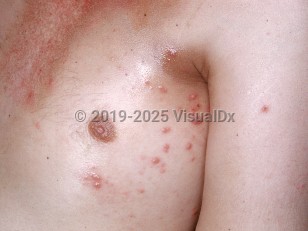Classical Hodgkin lymphoma: Classical Hodgkin lymphoma (cHL) may be associated with Epstein-Barr virus (EBV) infection, immune suppression, or autoimmune disease in some cases. It has bimodal age distribution, with one peak at 15-34 years of age and the second peak after age 50. EBV-associated cases are more commonly seen in children or immunocompromised patients (eg, HIV-infected patients) and has a higher incidence in developing countries.
cHL is made up of four subtypes:
- Nodular sclerosis cHL (the most common subtype; > 70% of cases)
- Mixed cellularity cHL (up to 20%-25% of cases; more often associated with EBV)
- Lymphocyte-rich cHL (up to 5% of cases)
- Lymphocyte-depleted cHL (< 1% of cases; more often associated with EBV)
Most patients with cHL will present with asymptomatic lymphadenopathy or finding of an incidental mass on chest radiography. Approximately 4 in 10 will have B symptoms (fever, night sweats, or weight loss) at the time of diagnosis. While the disease tempo is variable, it is generally slow, and symptoms of lymphadenopathy and B symptoms are recognized in retrospect to have begun weeks to months prior to the patient's evaluation for cHL.
For cHL, prognosis depends mostly on the stage of disease, with a 5-year survival rate of 90% for stage 1 or 2a. Stage 4 disease has a 5-year survival rate of 60%.
Nodular lymphocyte predominant Hodgkin lymphoma: Nodular lymphocyte predominant Hodgkin lymphoma (NLPHL) is less common (about 5% of patients diagnosed with Hodgkin lymphoma). It is a more indolent lymphoma and often asymptomatic. It tends to involve peripheral lymph nodes. Extranodal involvement is less common. Morphologically, it is characterized by lymphohistiocytic RS cell variant, L&H cells, which are mummified-appearing large cells that are sometimes referred to as "popcorn" cells due to their irregular contours and washed-out chromatin pattern.
For NLPHL, prognosis is favorable, with complete remission reported in > 90% of patients with favorable early-stage disease, 86% in unfavorable early-stage disease, and 77% in advanced-stage disease.
Related topic: non-Hodgkin lymphoma



